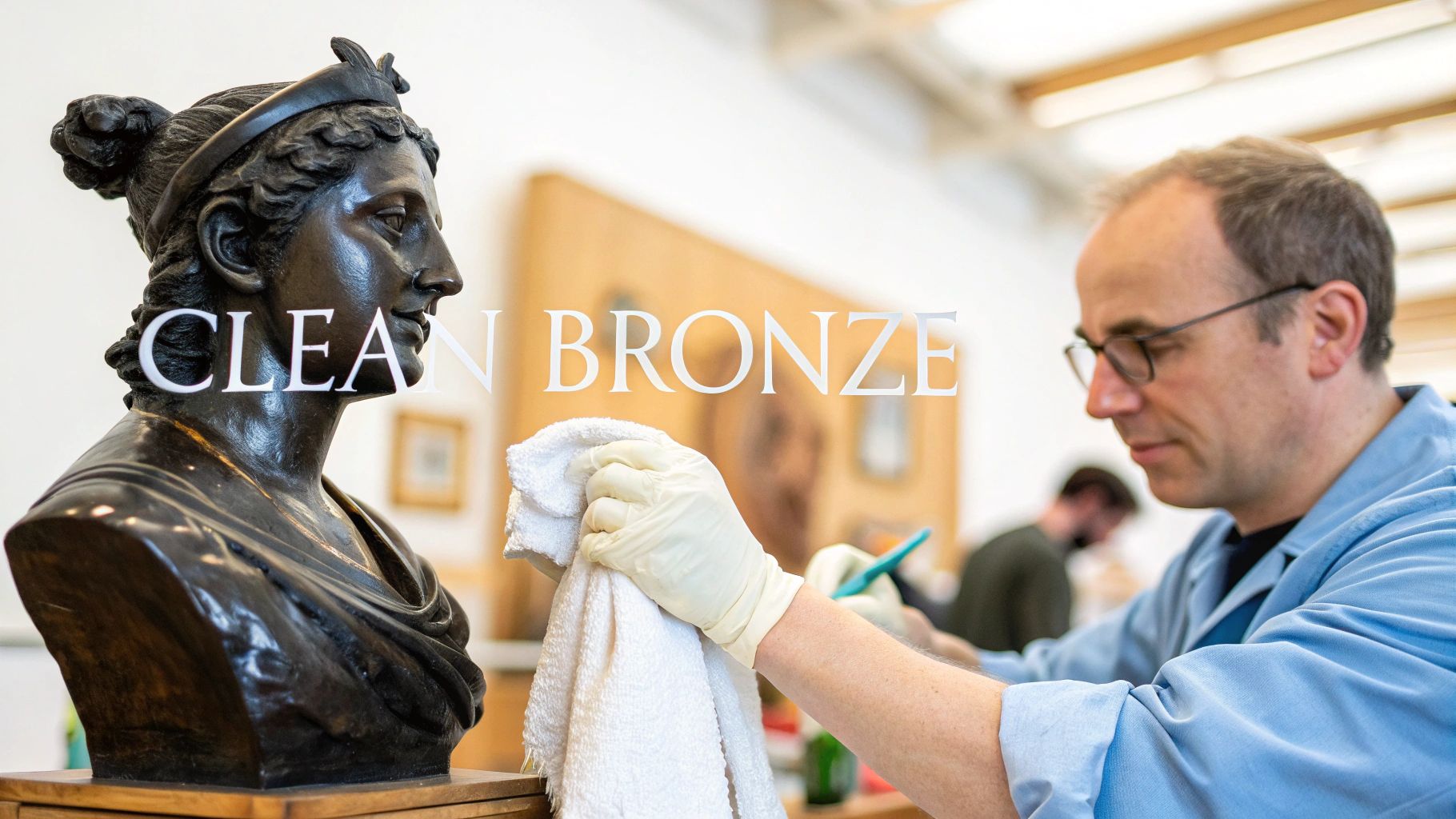When it comes to cleaning a bronze statue, the golden rule is "less is more." The entire goal is to preserve its valuable patina, not strip it away to reveal shiny metal underneath. This process starts with a gentle touch, using simple tools like distilled water and a pH-neutral soap, and requires a careful eye to know what you’re looking at.
Harsh chemicals and aggressive scrubbing are off-limits—they can cause irreversible damage and tank the statue's value.
What to Know Before You Clean Your Bronze Statue
Before you even grab a cloth, you need a fundamental shift in mindset. Many people new to bronze care think the objective is to make it gleam like a freshly minted coin. That's a huge—and often very expensive—mistake.
The dark, rich surface that develops on bronze over time isn't just tarnish; it's called a patina. Think of it as the statue's history, etched onto its surface. This layer not only gives the piece its unique character but also acts as a vital protective shield against the elements. If you're curious about how this material is worked and finished, it's worth taking a moment to understand how bronze statues are made.
Scouring away that patina is like tearing a chapter out of a rare book. It can take decades, sometimes centuries, to form naturally, and once it's gone, it's gone for good.
Patina vs. Corrosion
Your first real job is to play detective. Get up close and really inspect the surface. You need to learn the difference between a healthy, desirable patina and the kind of active corrosion that's actually damaging the metal.
Before you start, it’s a good idea to know what kinds of cleaners are safe for materials like bronze. The key is understanding neutral pH cleaners, which won't react with the metal.
To help you tell the difference between what's good and what's bad for your statue, here's a quick guide to reading its surface.
Identifying Bronze Surface Conditions
| Surface Condition | Appearance | What It Means | Recommended Action |
|---|---|---|---|
| Healthy Patina | Smooth, even layer of green, brown, or black hues. Feels solid. | A stable, protective layer that adds historical and aesthetic value. | Leave it alone! This is the goal. Gentle dusting is all that's needed. |
| Active Corrosion | Light green, powdery, or fuzzy spots. May flake off easily. | A destructive chemical reaction, often called "bronze disease," that is eating the metal. | Isolate the statue and seek professional conservation advice immediately. |
| Grime & Dirt | A dull film of dust, soot, or organic matter (like bird droppings). | Surface-level contaminants that can trap moisture and pollutants. | This can be gently cleaned with distilled water and a pH-neutral soap. |
| Wax Buildup | Waxy, uneven, or cloudy-looking patches. May feel sticky. | Old protective wax coatings have broken down or were poorly applied. | Can be carefully removed and reapplied, but may require a professional. |
In short, think of a healthy patina as the beautiful, protective bark on an ancient tree. Bronze disease, on the other hand, is a fungus actively destroying it. You want to preserve the bark, not feed the fungus.
The Risk of Over-Cleaning
The temptation to polish can be strong, but using the wrong products poses a serious threat to the statue's integrity. Most international restoration guidelines strongly advise against using any kind of metal polish for routine care. In fact, for most indoor pieces, a careful dusting with a soft, dry cloth is all that's ever needed.
If you spot those tell-tale powdery, light-green spots of "bronze disease" (cuprous chloride), that's your cue to stop. This is a clear signal that home remedies won't cut it. It’s time to call in a professional conservator to halt the decay and save the piece.
Gentle Cleaning Methods for Indoor Bronze
When it comes to caring for an indoor bronze statue, less is almost always more. Because it’s protected from the elements, your piece lives in a controlled environment. This means aggressive cleaning is not only unnecessary but can actually be the fastest way to ruin its finish and diminish its value. I always tell people to start with the simplest, most conservative approach first.
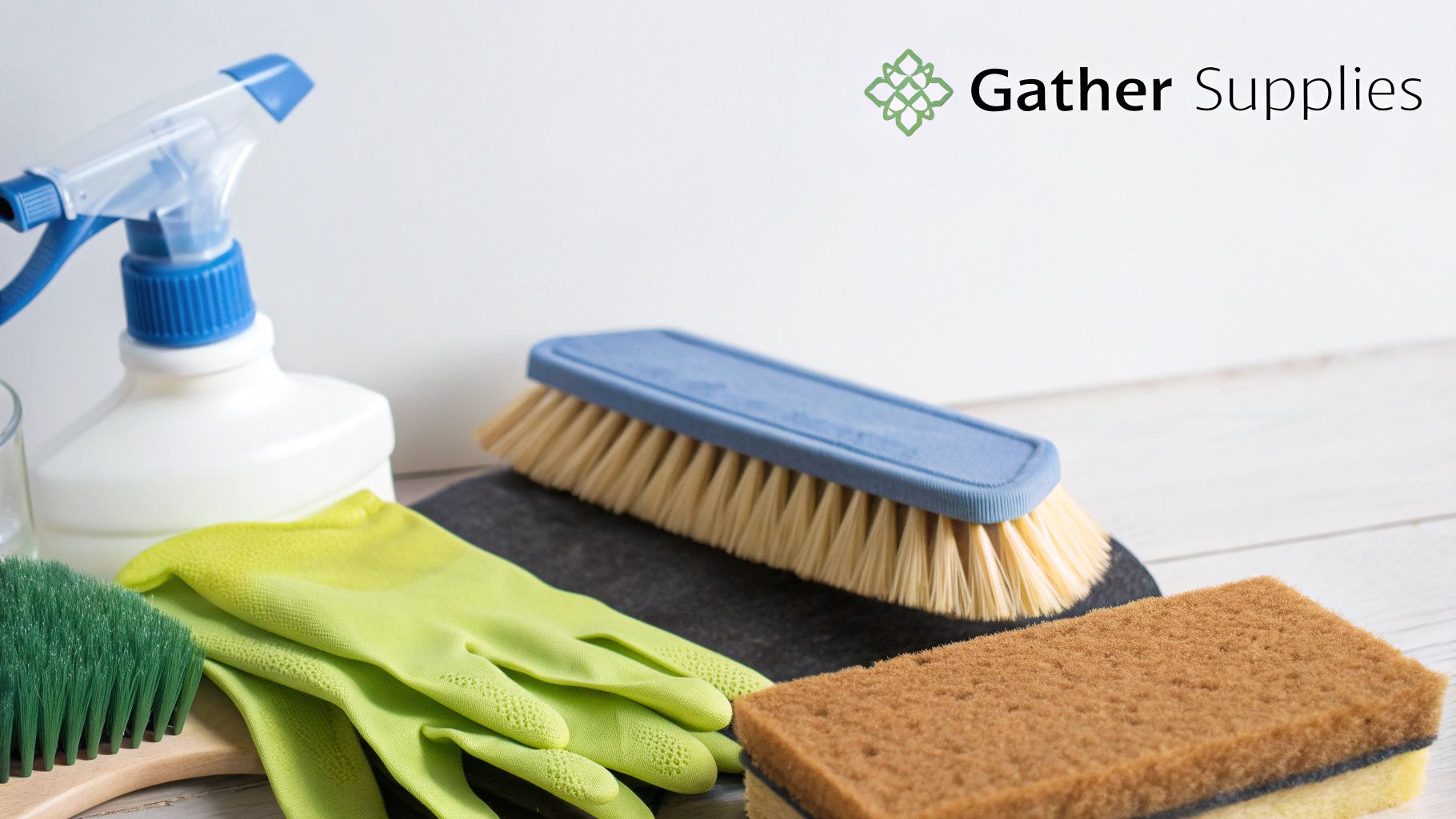
Your first line of defense is just a simple dusting. Over time, that fine layer of dust doesn't just dull the shine; it can trap airborne pollutants that might react with the patina.
The Initial Dusting
For routine upkeep, a light dusting once a week is usually all you need. Grab a clean, dry microfiber cloth—its fibers are fantastic at grabbing dust particles without leaving behind any scratches.
What about those tricky, detailed areas? For intricate carvings or complex textures, a very soft-bristled brush is your best friend. I often recommend a clean makeup brush or a new, high-quality paintbrush to gently flick dust out of those hard-to-reach spots.
A quick word of warning: stay away from feather dusters. Their quills can be sharp and scratch the finish, and they mostly just push dust around instead of capturing it.
When Dusting Isn't Enough
Sometimes, dust isn't the only issue. Maybe the statue was near a kitchen and has a slightly greasy film, or perhaps it’s been handled a lot, leaving fingerprints. In these cases, you’ll need to step things up a notch with a mild soap solution.
The most important ingredient here is distilled water. It’s a small detail that makes a huge difference. Regular tap water is full of minerals that leave behind chalky white spots as it evaporates, which completely undermines your cleaning efforts.
Next, you need a pH-neutral soap. A simple, clear dish soap without any extra dyes, perfumes, or heavy degreasers is perfect. You only need a tiny amount—just a few drops in a small bowl of distilled water. You're aiming for a very weak solution, just enough to gently lift the grime without being harsh.
Pro Tip: Before you clean the whole piece, always test your soap solution on a small, hidden spot, like the underside of the base. Let it dry completely to make sure it doesn’t cause any discoloration or weird reactions with the patina.
To start cleaning, get a soft, lint-free cloth and dampen it with your solution. Wring it out thoroughly until it's just barely damp. Gently wipe the surface of the statue, moving in small, manageable sections.
Right after wiping with the soap solution, use a second cloth dampened with only distilled water to "rinse" off any soap residue. The final step—and it's a critical one—is to dry the statue completely with a clean, soft towel. Be meticulous, as any moisture left hiding in crevices can encourage corrosion.
What You Must Never Use
This is where many well-intentioned owners go wrong. Many common household cleaners will cause irreversible damage to bronze, stripping the patina and leaving behind ugly streaks or pits.
Products to Avoid at All Costs:
- Vinegar or Lemon Juice: The acid in these is highly corrosive to bronze. It will eat right through the patina, often leaving unnatural, bright pinkish spots.
- Abrasive Polishes: Any commercial metal polish intended for brass or silver is far too aggressive. It will remove the protective patina you're trying to preserve.
- Baking Soda Pastes: Baking soda is an abrasive, and a paste made from it will absolutely scratch the delicate surface of your statue.
- Ammonia-Based Cleaners: Products like window cleaners that contain ammonia are extremely destructive and should never touch your bronze.
It’s fascinating how different metals require such different care. While these rules are crucial for bronze, the approach varies wildly for other materials. For example, the techniques for how to remove tarnish from silver are completely different, which really drives home why material-specific knowledge is so important.
Tackling the Grime on Your Outdoor Bronze Sculpture
Bronze statues living outdoors have a much tougher life than their indoor cousins. They're constantly up against acid rain, bird droppings, sticky tree sap, and all sorts of airborne pollutants. Over time, this builds up into a stubborn layer of grime that needs a careful, yet slightly more assertive, cleaning approach.
This is a method straight from the pros, but it's completely safe to do yourself with the right supplies.
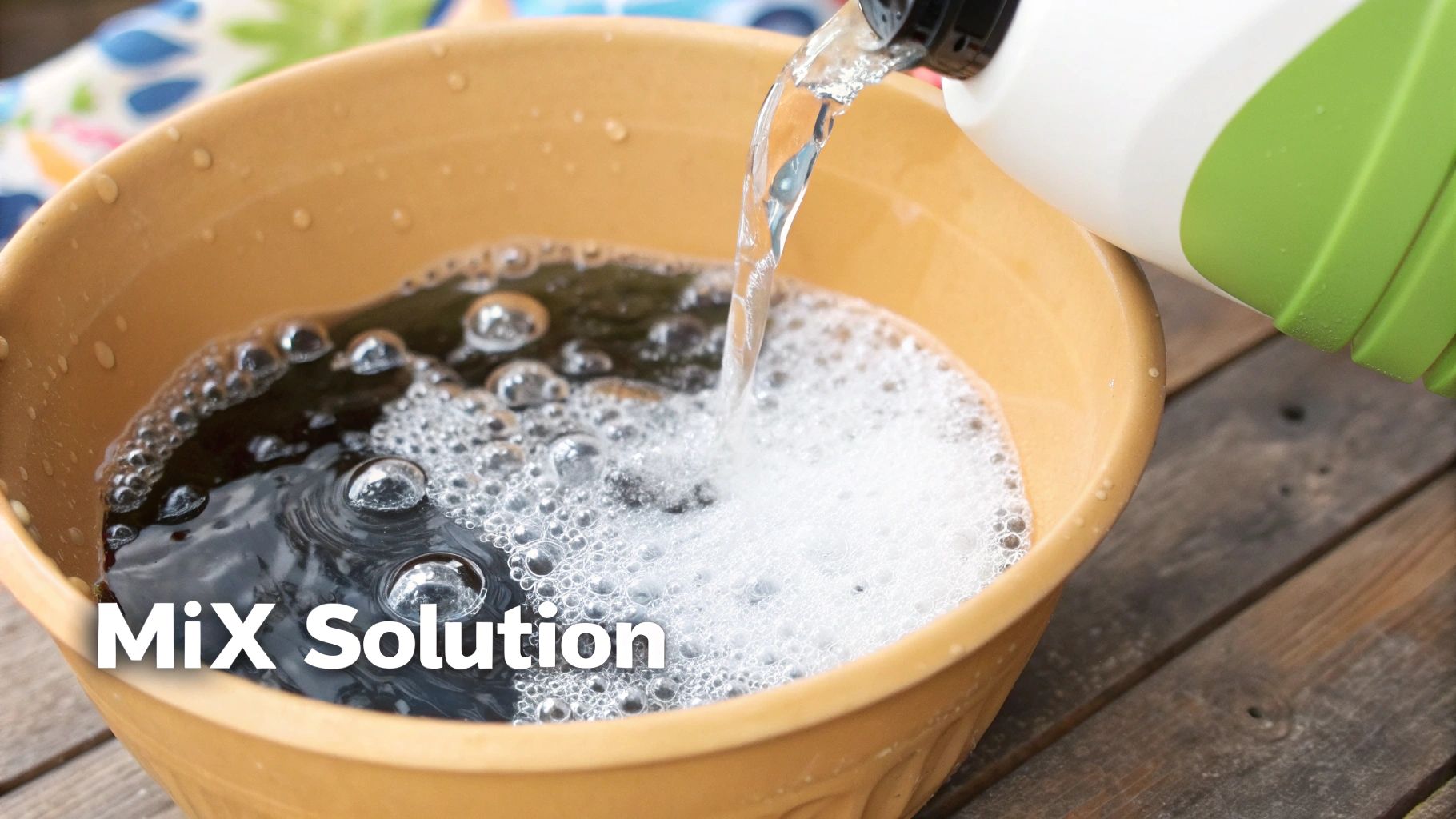
The secret lies in choosing the right cleaning agent. While a simple pH-neutral soap might be fine for a little indoor dust, the baked-on grime of the outdoors calls for something with more power—but without harming that delicate patina.
Why Conservation Pros Use Non-Ionic Detergents
For a deep clean that’s truly safe, the go-to for professional conservators is a non-ionic detergent. You might see names like Triton X-100 if you're shopping around. Unlike your average dish soap, these detergents are designed to lift and trap dirt particles without chemically reacting with the bronze itself. This means you can get rid of the gunk without stripping away the beautiful, aged surface.
You can usually find these detergents at online conservation supply stores or specialty chemical suppliers. Don't worry, a little bottle will last you a long time.
To mix your cleaning solution, you'll want a very weak dilution—aim for a 3-5% concentration in distilled water. That’s roughly one or two ounces of detergent for every gallon of water. It’s always best to start weaker; you can always make it a bit stronger if the dirt isn't budging.
This isn't just a random tip; it's standard practice in the conservation world. A survey of professionals showed that a whopping 87% prefer using gentle, water-based cleaners like non-ionic detergents because they work effectively while preserving the statue's integrity. For a deeper dive, check out the professional conservation techniques at GSA.gov.
With your solution mixed, grab a soft, natural-bristle brush (horsehair is perfect) and dip it in. Work in small, gentle circles across the statue’s surface. You’re not trying to scrub the patina off; you're just agitating the grime so the detergent can lift it away.
Rinsing Well and Using a Low-Pressure Washer (Carefully!)
Once you're done scrubbing, rinsing thoroughly is absolutely critical. Any detergent left behind will just become a sticky magnet for new dirt.
Start by rinsing with clean distilled water from a spray bottle or a garden hose on a very gentle setting.
For larger statues, a low-pressure washer can be a real time-saver, but you have to be extremely careful. The key word here is low pressure.
Guidelines for Using a Pressure Washer Safely:
- Keep the PSI low. Start with the absolute lowest setting your machine has, usually around 500-800 PSI. You should never go above 1000 PSI on bronze.
- Use a wide-angle tip. A 40-degree (white) or 65-degree (black) nozzle is what you want. This spreads the pressure out. Never, ever use a zero-degree (red) pinpoint nozzle—it will scar the surface.
- Keep your distance. Stand back at least two to three feet from the bronze. Always test the spray on a hidden spot first to see how the surface reacts.
While some professional pressure washing services are great for driveways and siding, their high-powered equipment can be far too aggressive for a delicate bronze surface.
No matter how you rinse, the final step is to pat the entire statue completely dry with soft, clean towels. This prevents water spots and mineral deposits from ruining your hard work.
Knowing When to Call in a Professional
Learning how to care for your bronze statue is a valuable skill, but the single most important lesson is knowing when to step back. There are times when even the best intentions can lead to irreversible damage. Recognizing the difference between a simple cleaning job and a serious conservation issue is key to protecting your artwork's integrity and value.
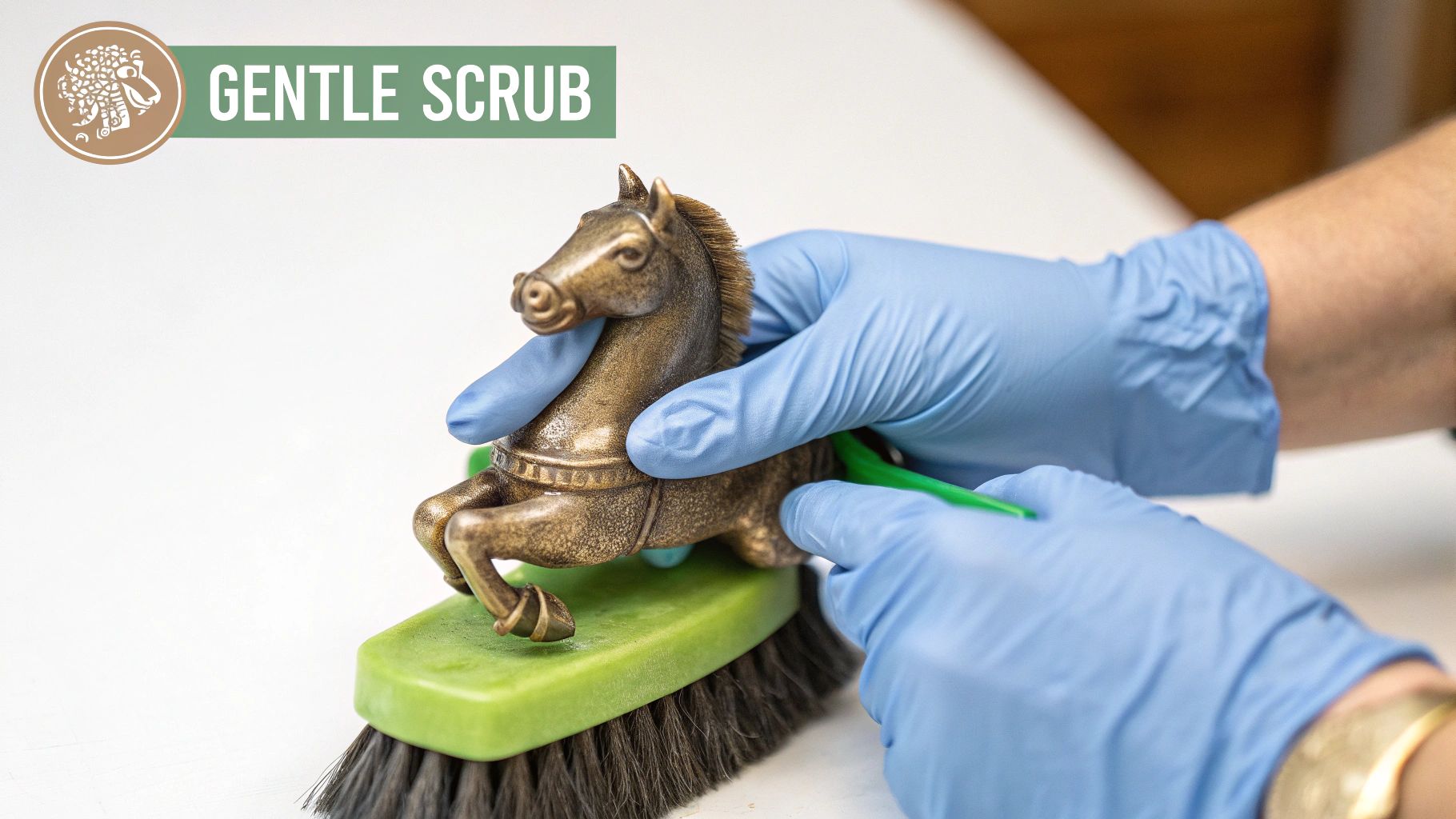
Honestly, sometimes the best tool for the job is your phone. A professional art conservator has spent years training and has access to specialized tools and chemicals that can solve problems without creating new ones.
Red Flags That Mean You Need an Expert
If you spot any of the following issues, it's time to pause and consult a professional. These aren't just surface-level dirt; they're signs of deeper problems that need an expert touch.
- Active Corrosion (aka "Bronze Disease"): This is the big one. If you see light green or whitish spots that look powdery or even a bit fuzzy, that’s a major warning sign. This isn't the desirable, stable patina—it's a chemical reaction that is actively destroying the metal.
- Deep or Stubborn Stains: You've tried the gentle cleaning methods, but that stain from bird droppings or pollution just won't budge. The temptation is to grab a stronger chemical, but don't do it. You could easily end up with a bleached-out, permanently discolored patch.
- Flaking or Unstable Surfaces: Does the surface of the bronze feel weak? Is the patina peeling or flaking off? Trying to clean an area like this could cause a whole section to break away.
- Evidence of Bad Repairs: Mismatched color patches, thick and goopy wax jobs, or other signs of old, failing repairs are a clear signal to stop. A conservator needs to assess the situation before you add another layer to the problem.
Trying to tackle these issues on your own is a bit like trying to perform surgery after watching a YouTube video. You might get rid of the visible symptom, but you could make the underlying condition far worse. Scrubbing at bronze disease, for example, can actually push the corrosive elements deeper into the metal.
A conservator’s whole philosophy is built on minimal and reversible intervention. Their goal isn't to make an old piece look brand new; it's to stabilize it and preserve its history for generations to come.
What a Professional Can Do
A trained conservator has techniques at their disposal that simply aren't available to the public. For instance, they might use walnut shell blasting to remove thick grime or a failing protective coating from a large outdoor sculpture.
It sounds aggressive, but it's a remarkably gentle process. Finely ground walnut shells are projected at a very low air pressure, lifting away contaminants without damaging the delicate patina underneath. It's a method that has been used by the National Park Service for years. A skilled operator will work just 3 to 6 inches from the surface with air pressure kept under 25-30 psig for maximum control. You can dive into the nitty-gritty of these conservation methods on the NPS website.
On a related note, understanding the history of your piece can be a huge help when talking to a conservator. Knowing who the artist was or where it was cast can provide clues about the original finish. If you're curious about your statue's origins, learning how to start identifying bronze foundry marks can be a fascinating first step.
Protecting Your Bronze Statue for the Long Haul
Once your statue is clean and completely dry, you're on the home stretch. But don't put your supplies away just yet. The single most important thing you can do now is apply a protective barrier.
Think of it this way: cleaning gets rid of the immediate problem, but waxing is what prevents it from coming right back. This final layer is your statue's best defense against moisture, pollution, fingerprints, and dust. If you skip this, you’ll find yourself doing deep cleans far too often, which can wear down the statue's surface over time. We're aiming for preservation, not just repeated cleaning.
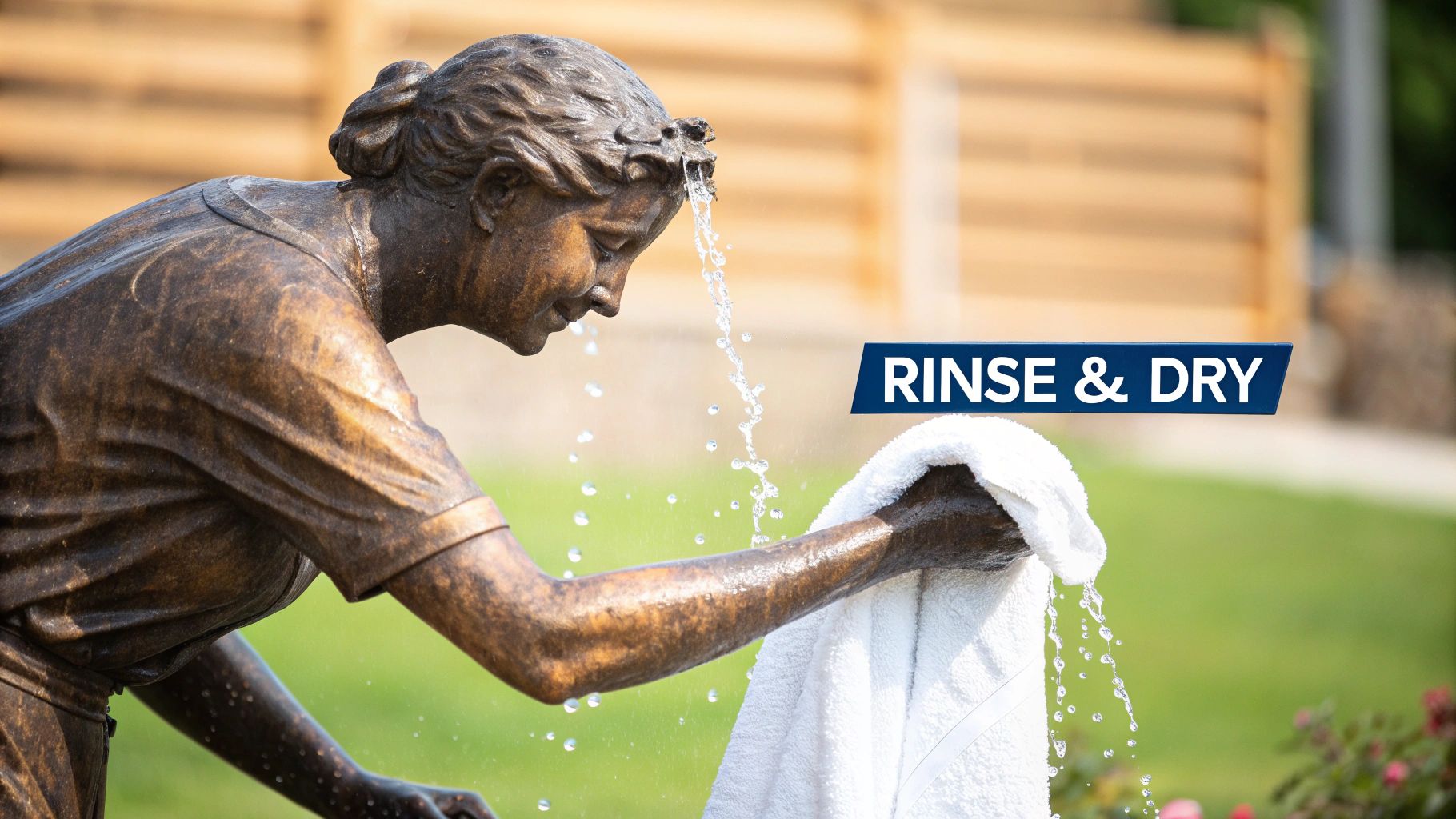
Applying a Museum-Quality Wax Coat
So, what should you use? The gold standard in the conservation world is microcrystalline wax. This is what museums and professional restorers rely on because it creates a tough, clear shield that won't yellow or damage the patina. A trusted brand like Renaissance Wax is an excellent choice.
Before you even open the tin, double-check that the statue is bone dry and sitting at room temperature. Trapping even a tiny bit of moisture under the wax is a recipe for corrosion down the road.
Here’s my tried-and-true process for getting a perfect finish:
- Start small. Dab a clean, lint-free cotton cloth into the wax. You need much less than you think—a little truly goes a long way.
- Apply a thin, even layer. Work in small, circular motions, gently rubbing a whisper-thin film of wax over the surface. Make sure you get into all the nooks and crannies. The goal is a coat so thin you can barely see it.
- Let it haze over. Now, walk away for about 15-20 minutes. The wax needs time to cure and will develop a soft, hazy look, much like when you wax a car.
- Buff to a gentle luster. Take a second clean cloth and lightly buff the entire statue. You’re not trying to create a mirror-like shine. Instead, you want a deep, rich glow that brings out the complexity of the patina.
A Word of Caution: Stick to pure, conservation-grade waxes. Many household or automotive waxes contain cleaning agents or abrasives that can harm your statue's finish. Remember, two or three incredibly thin coats are always better than one thick, goopy one.
A Simple Maintenance Schedule for Lasting Beauty
Regular, gentle upkeep is the key to making sure your bronze stays in pristine condition. This simple routine will drastically reduce how often you need to do a full-on deep clean. The right schedule really just depends on whether your piece lives indoors or out.
A little proactive care goes a long way. This checklist will help you keep your bronze looking fantastic with minimal effort.
Bronze Statue Maintenance Schedule
| Task | Indoor Statue Frequency | Outdoor Statue Frequency | Key Tips |
|---|---|---|---|
| Gentle Dusting | Weekly | Monthly | Use a soft microfiber cloth or a soft-bristle brush for detailed areas. |
| Inspect Surface | Monthly | Monthly | Look for any new stains, sticky spots, or signs of corrosion. |
| Re-apply Wax | Every 1-2 years | Every 6-12 months | Adjust based on exposure. A statue under a covered porch needs less frequent waxing than one in direct sun and rain. |
By following this simple schedule, you're not just maintaining an object; you're preserving a work of art, ensuring its beauty and integrity for many years to come.
Common Questions About Cleaning Bronze Statues
Even with the best instructions, you're bound to have questions once you get started. It's only natural. Let's walk through some of the most common uncertainties people have when they first learn how to clean a bronze statue.
What Should I Do About Minor Scratches?
Finding a new scratch on your statue can be disheartening, but the first rule is: don't panic. Resist the urge to grab an abrasive polish or start rubbing it aggressively. That almost always makes things worse.
For a light surface scuff, your best bet is often a fresh, careful application of microcrystalline wax. Gently working the wax over the area can help camouflage the mark, blending it seamlessly into the surrounding patina.
If you’re looking at a deeper gouge, it's time to step back. A professional conservator has the tools and expertise to address a significant scratch without harming the statue. A well-intentioned DIY repair on a deep scratch can quickly become a permanent, costly mistake.
Can I Use Vinegar or Lemon Juice for Tough Stains?
This is a hard no. It's a critical point that can save your statue from irreversible damage. You might see household tips suggesting acidic cleaners like vinegar or lemon juice for brass and copper, but applying them to a work of art is a disaster.
The acid will chemically strip the patina right off the surface. You'll be left with a glaring, raw-looking pink or bright gold spot that stands out like a sore thumb. This isn't just a cleaning mistake; it's permanent damage that can seriously devalue the piece. Stick to pH-neutral soap and distilled water, always.
The patina on a bronze statue is its history and character, built up over years or even decades. Using harsh, acidic chemicals is like trying to erase that story. The goal is always preservation, not stripping it back to a factory-new shine.
How Does Climate Affect an Outdoor Statue?
The environment is a massive factor in how your outdoor bronze will age. Where you live dictates how often you'll need to clean and wax the piece to keep it protected.
- Coastal Areas: Salt in the air is relentless and highly corrosive. If you're near the ocean, your statue needs more frequent rinsing with fresh water to wash away salt deposits. Plan on waxing it at least twice a year to create a barrier.
- Urban Environments: City pollution and acid rain are tough on bronze. These pollutants can slowly eat away at the patina. A solid coat of wax is your best defense, along with regular inspections for grime and buildup.
- Humid Climates: Constant moisture is an open invitation for corrosion. Make sure your statue isn't sitting in a spot where water pools and that it has good air circulation. After any cleaning, it's absolutely crucial to ensure it dries completely.
What if I See Powdery Green Spots?
If you notice any powdery, light green or whitish-blue spots, stop what you’re doing immediately. This isn’t the beautiful, stable patina you want. This is a sign of active corrosion known as "bronze disease." It’s a nasty chemical reaction that is literally eating the metal.
Whatever you do, don't try to scrub or brush it off. You risk spreading the corrosive chlorides and pushing them deeper into the pores of the bronze. This is a clear signal that you need to call in a professional art conservator. They can properly treat the corrosion and stabilize the metal to prevent it from spreading.
Feeling curious about the history behind your own treasures? With the Curio app, you can uncover the story and value of your antiques with just a photo. Download Curio today and let your antiques tell their story.
